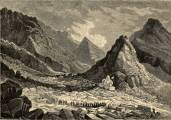


Excerpts From
Construction Materials in Phillips
County, Kansas
Geological Survey Circular 21
By Frank E. Byrne, Henry V. Beck,
and Max S. Houston
Department of the Interior for Development, Geological
Survey
Washington, D. C., April, 1949
Purpose of the Investigation
The Geological Survey, U. S. Department of the Interior, in the summer of 1946, sent a field party into Phillips County, Kans. As originally planned the field party was to investigate sources of riprap and aggregate in the immediate vicinity of the proposed Kirwin dam, in the southeastern part of Phillips County.1 The State Highway Commission of Kansas and the United States Geological Survey were already cooperating in the compilation of a State-wide inventory of construction materials, so it was decided to enlarge the scope of the investigation in Phillips County to include an inventory of all such materials available in that area. This report, therefore, will include not only the information on sources of riprap and aggregate desired by the United States Bureau of Reclamation but will also contribute to the completion of the State-wide inventory desired by the State High Commission..
.
Area covered by the investigation
Phillips County is in the first tier of Kansas counties south of the Nebraska boundary and in the fifth tier east of the Colorado boundary. (See pl. 1.) It comprises 25 townships and covers an area of about 900 square miles. The county lies between 39° 32.5' and 40° north latitude and 99° 04.' and 99° 37.5' west longitude. It is bordered on the east by Smith County, on the west by Norton County, on the south by Rooks County, and on the north by Harlan and Franklin Counties, Nebr.
Geography of the Area
Phillips County is in the border region of the Great Plains physiographic province. Streams cutting headward from the lower level of the Central Lowlands province, which lies to the east, have dissected the border region into an area of low to moderate relief. The streams occupy steep-sided valleys cut as much as 200 feet below the gently rounded upland surface. The areas of greatest relief in Phillips County are a belt along the south side of the valley of North Fork Solomon River and an eastward-trending belt that includes about one-third of the county just south of the Nebraska boundary. The point of lowest altitude in the county, about 1,680 feet, is along the North Fork Solomon River at the eastern county line. The highest altitudes, about 2,300 feet, are on the divide in the northwest corner of the county..
Three railways serve Phillips County. A branch line of the Chicago, Rock Island & Pacific Railroad trends towards the west across the center of the county and is paralleled, about 6 miles to the south, by a branch line of the Missouri Pacific Railroad. A branch of the Chicago, Burlington & Quincy Railroad cuts across the northwest corner of the county. Phillipsburg, the county seat and the largest city in the county, is served by the Rock Island Railroad, as is Agra. the cities of Kirwin, Speed, and Logan are situated along the Missouri Pacific.
The county has a well-developed system of Federal, State, and county roads. The Federal highways are of the black-top type of construction. U. S. 36, a major east-west transcontinental route, parallels the Rock Island Railroad; U. S. 183, an important north-south highway, extends through the center of the county; and U. S. 383 approximately parallels the Burlington Railroad across the northwest corner. The several State highways in Phillips County are metalled, all-weather roads. The roads maintained by the county are on a section-line basis and are only infrequently metalled; they are maintained by grading.
Inventory of Construction
Materials
(Note: Only the section on "Structural Stone" will be included here.)
-
Plate 4. Map showing a quartzite prospect, near Glade, Phillips County, Kans. Adapted from map prepared by the U. S. Bureau of Reclamation, 1946.

Structural Stone
Geologic Formations and
Their Construction Materials
(Only formations that include building stone are listed below.)
(1) Fort Hays Limestone Member of Niobrara Formation:
Structural Stone: The Fort Hays limestone has been used locally as structural stone for dwellings, farm buildings, and business houses. The stone appears to harden after being cut, and structures built of it stand up well in the relatively dry climate of western Kansas. Field observations indicate that the Fort Hays limestone should not be used in a place where it is subject to water saturation, such as in the foundations of buildings. In such places the stone deteriorates fairly rapidly by freeze-and-thaw or slaking or through both processes.
(2) Ogallala Formation:
Structural Stone: The test characteristics and field observation of the quartzite indicate that it is acceptable for use as structural stone. Quartzite was used in the construction of the city auditorium in Phillipsburg, Kans., with very satisfactory results. Because of its hardness the quartzite will be more difficult to tool than limestone.
1 Construction Materials in Cloud County, Kansas, 1951, page 1, footnote 1: Missouri River Basin, conservation control, and use of water resources: 78th Cong., 2d sess., S. doc. 191, 1944.
Commercial use of material within this site is strictly prohibited. It is not to be captured, reworked, and placed inside another web site ©. All rights reserved. Peggy B. and George (Pat) Perazzo.

